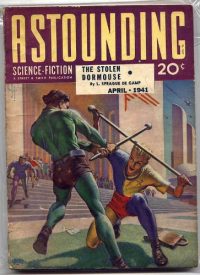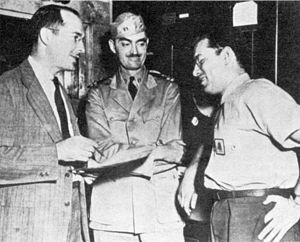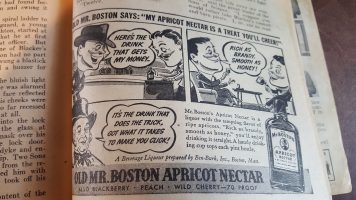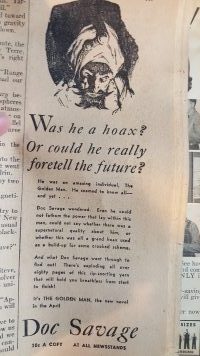Greetings all
You have my apologies for not getting a chance to review a magazine last week. It will happen again next week as I’m on the road for most of the week.
This week, I’ll be reviewing the Astounding from May, 1941 (Vol. XXVII, No. 3). This is the first time I’ll be reviewing a magazine where I’ve read the issue immediately before or after. You can find my review for April, 1941 here: https://robhowell.org/blog/?p=1352.
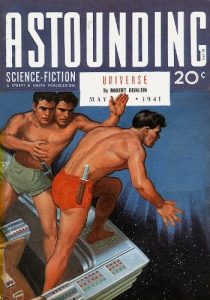
Table of Contents: http://www.isfdb.org/cgi-bin/pl.cgi?57588
This issue starts out with an editorial by John W. Campbell entitled History to Come. The opening line is a fun one to remember. “Fundamentally, science-fiction novels are “period pieces,” historical novels laid against a background of a history that hasn’t happened yet” (p. 5). I like that thought, especially since Campbell uses this editorial to discuss what that means. He focuses especially on the research involved and emphasizes that what an SF author should be doing is “mental research into possible future” (p. 5). He does this to set up Robert A. Heinlein’s “History of Tomorrow” timeline, which we’ll discuss in about 120 pages.
As I research this editorial and wallow in Campbell’s brilliance (and, of course, Heinlein’s), I discovered something very interesting. Alexei and Cory Panshin said in The World Beyond the Hill that this idea of world creation, which seems fairly obvious to me, changed science fiction. “Science fiction hadn’t been seen in these terms previously. But the publication of Heinlein’s Future History chart would force a general alteration of perception of what science fiction was about and how it was made” (Alexei and Cory Panshin, Heinlein and the Golden Age (excerpt of The World Beyond the Hill), https://www.panshin.com/critics/Golden/goldenage3.html). I suggest you all read the whole article.

Then there’s an ad for the Street & Smith Baseball Yearbook of 1941. As a guy who got into sabermetric research in the late 80s, I think this is awesome. It’s the forerunner of Bill James and those who followed him.
That’s a young Bob Feller on the cover, by the way. He would play the summer of ’41, and do well, though not as well as in 1940. Then, of course, he loses 1942-44 and most of 1945 for the war, serving part of that as a Chief Petty Officer on the USS Alabama. I hadn’t actually caught that before, and it makes my time roaming around the Alabama a bunch of times as a kid even that more awesome.
These magazines are like traveling in time.
Anyway, I suppose we should actually turn to the fiction. The first story is Universe by Heinlein. Not surprisingly, given Campbell’s editorial, we see some of Heinlein’s most intricate world-building in this story.
The story is about a generational ship on its way to the stars. One fascinating little touch Heinlein used was the standard greeting, “Good eating.” With just that little bit, we learn a ton about the time and place. He’s so deft.
And the story is really good. What happens to humanity if they’re on a generational ship and many generations pass? What happens to their understanding of science? To their society?
It would change, undoubtedly. Our hero is someone who has grown from that society, raised by exiled muties, and learns the truth of their ship. His is now the job of tilting at the windmill of those generations’ evolution to get them, perhaps, finally, to Centaurus.
Oh, look. We move from Heinlein to Isaac Asimov. What a darn shame, having to read these two hacks. Such a bummer. Anyway, the story is another early Robot one starring Susan Calvin called Liar.
You’ve probably read this story as it was reprinted a bunch of times, but here’s a synopsis anyway. A brand new robot has the astounding ability to read minds, though how its positronic brain gained this talent is unknown and is completely not repeatable until they learn just how it happened.
RB-34, Herbie, is programmed with early versions of the Three Laws of Robotics, so this ability is a real problem for it. When it talks to people, it knows what they want, so telling them the truth might actually hurt them. So, it supplies the answer that the person talking to them wants.
Of course, this leads to conflict as Calvin desires the love of one of the other scientists and another character hopes to be the next director. After they realize Herbie is providing different answers to each person, they confront him. Now, Herbie is in an insoluble situation. No matter what he says, he will hurt at least one of the humans. In the end, he collapses in positronic insanity.
I love Asimov’s Robot stories because he’s so good at creating logic puzzles. Reading these stories in original form is incredibly fascinating because the laws of Robotics aren’t actually specified until 1942. In some ways, this is Asimov fumbling towards something amazing.
And yes, its a great story. Shocking, I know.
So we move to a story called Solution Unsatisfactory by Anson MacDonald. There’s a goodly amount to unpack in the author here, because that’s a pseudonym for Heinlein. Yes, he’s got two stories in this issue. What a fascinating time that was for science fiction.
And dates are really important when unpacking this story. This issue was released in May of 1941. The story is, essentially, about Mutually Assured Destruction. He’s asking the same questions that Truman would have to answer in 1945 and in the years following.
MAD was, and is, an unsatisfactory solution. Heinlein proposed another, that of a world-wide dictatorship which has a monopoly on the superweapon, but even he points out that will never work. Campbell has a follow-up to this story where he asks for any better suggestion. The request is almost pleading.
Moving on we get In Times to Come, the preview of the next issue. It promises a neat murder mystery, a “whodunit-to,” if you will, that helps deal with the challenge of writing a murder mystery in science fiction. The story is Ross Rocklyne’s Time Wants a Skeleton. I’m looking forward to reading that when I find that issue.
Also on that page is the scores from the ratings of the previous issue. Yeah, Heinlein might be good and really prolific at this time. The April issue also has one by him and one by him as Anson MacDonald. They were, by a large margin, the best-rated stories of that issue.
The next story is Eric Frank Russell’s Jay Score. This wasn’t a bad story, but I’ve had the twist before. It’s about a freighter that is blown off course by a micro-meteorite. It’s headed directly to the sun with broken rockets. They get the rockets going, but even so a slingshot around the sun will be difficult.
They only manage it because of Jay Score, the assistant pilot. He’s a larger than life figure. Six foot nine or so, laconic, immensely capable, and so good at chess that he’s actually able to be the Martians on occasion. He is, of course, a robot names J.20.
As I said, it’s a twist I’ve seen before and done better. It’s the kind of deus ex machina that bothers me. Surviving only because he’s a robot means that there’s no real heroism involved. Robots can be heros, just look at Asimov’s examples. But here we’re expecting to see a hero and instead we see something superhuman. It lessens the story for me.
Next is a cute little entry called Fish Story by Vic Phillips and Scott Roberts. Basically, it’s about a an old colonel telling tall tales in a bar. This particular story is about catching highly poisonous giant frog-like creatures on Venus. He succeeds by the use of creative chemistry.
As I said, it’s a cute piece of fluff, but highlights one of the few drawbacks of this exercise. I often wallow in the history of these stories, like I did in Solution Unsatisfactory. However, that’s a two-edged sword. So many of these are set on Venus or Mars as if they’re teeming with life, which we now know isn’t true. It’s a case of knowing too much sometimes.
We move on to Subcruiser by Harry Walton. This is ripping yarn of a ship captain drugged by his executive officer so he can steal their subspace cruiser and take it to their enemies. The captain thinks the drugs are simply part of alcoholic fits brought on by depression from a previous battle.
In the end, he manages to defeat his XO and save his ship, and in the process regain the trust of his crew. Great story. To bad Walton didn’t write more.
Next we get to the monthly section called Brass Tacks. This one is special, though, as it publishes a chunk of Heinlein’s timeline, as mentioned in the opening editorial. The entire section can be found here: http://astoundingstoriesatwar.lmc.gatech.edu/files/original/5c982f03ae0d7bd88f8b8a0f636f3860.pdf.
Next is the conclusion of The Stolen Dormouse by L. Sprague de Camp. Here’s the link to my review of the Astounding of April, 1941 and Part I: https://robhowell.org/blog/?p=1352.
This story is a mashup of a number of different threads. A bit of Ivanhoe. A heaping helping of Romeo and Juliet. Some Purloined Letter. However, there are a ton of loose threads. The heroes survive and live happily ever after, so that’s fine, but I feel like the ending was rushed and condensed. De Camp almost built too much depth into this world, and I didn’t think all of it was explored enough.
If you go to the story’s Wikipedia page, it has a number of comments from a variety of different perspective and I think that’s part of my frustration. So much is going on, it’s written well, and it’s full of action, so it’s a good novella. It’d be a better better novel, though.
That’s it for this issue. It was another great issue, but it’s hard to go wrong with two Heinleins and an Asimov.
I’ll probably not have a chance to do a review next week, so I’ll plan on getting one out Halloween day. That being the case, I’ll review the Imagination of October, 1950. This is actually the first issue of this magazine. I’m curious what I’ll find in a debut.
Thanks very much and have a great day.
Next Week’s Issue: Imagination of October, 1950.
If you have any comments or would like to request I keep my eyes open for a specific issue or month, feel free to comment here or send an email to me at: rob@robhowell.org.
If you want to see previous reviews, the Mag Review category is here: https://robhowell.org/blog/?cat=432.
Have a great day.
Rob Howell
Author of the Shijuren-series of novels
- Website: www.robhowell.org
- Patreon: https://www.patreon.com/rhodri2112
- Blog: www.robhowell.org/blog
- Shijuren Wiki: http://www.shijuren.org/World+
of+Shijuren+Home - MeWe: https://mewe.com/i/rob.howell1
- Facebook Author Page: https://www.facebook.com/robho
well.org/ - Twitter: https://twitter.com/Rhodri2112

